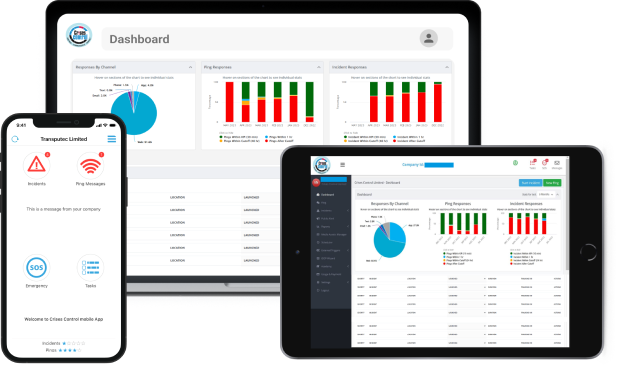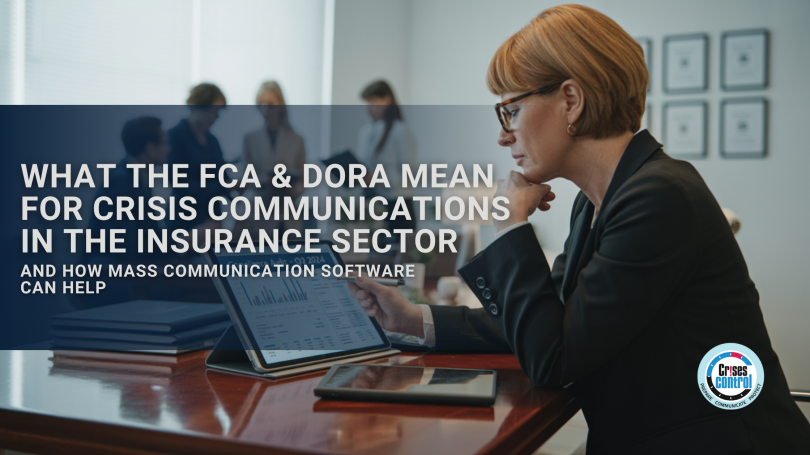Written by Anneri Fourie | Crises Control Executive
Introduction: Compliance Pressure Is Growing – Is Your Crisis Communication Keeping Up?
Insurance companies across the UK and EU are facing stricter oversight than ever before. The Financial Conduct Authority (FCA) has sharpened its focus on operational resilience, especially how firms communicate during incidents. At the same time, the EU’s Digital Operational Resilience Act (DORA) sets new standards for ICT continuity, with strict communication obligations during disruptions. Alongside this, Solvency II continues to demand strong governance and accountability.
This shift in regulation is creating a clear challenge: insurance providers must not only act quickly during a crisis but also prove that their actions were effective, timely, and compliant.
What’s often overlooked is that most insurers still rely on a mix of outdated communication systems, manual processes, or incomplete plans. This puts firms at real risk of breaching regulations, especially when they’re unable to keep all stakeholders informed during major incidents.
The solution lies in using a fit-for-purpose tool. Mass communication software is emerging as a key component in meeting compliance expectations and protecting reputation. In this article, we’ll explore how regulations are changing and what insurers can do to keep up, with practical insights into how Crises Control supports this process.
The FCA’s Expectations: Clear, Timely and Auditable Crisis Communications
Regulatory Focus Has Shifted
The FCA is no longer just interested in customer-facing documentation or financial stability. In recent years, it has made operational resilience a top priority. This includes how firms prepare for, manage, and recover from disruptions that affect services or customers.
The FCA expects insurers to have the ability to communicate effectively during disruptions, including with customers and regulators, and to ensure these communications are timely, accurate, and well-documented. Firms are expected to:
- Have a plan to deliver accurate information quickly to customers, partners, regulators, and staff.
- Ensure communications work even if core systems are down.
- Keep records of what was said, when, and to whom.
Without these, insurers risk falling short of FCA expectations. That can lead to sanctions, loss of customer trust, and even public criticism, particularly if communications are slow or confusing during a major event like a cyberattack or service outage.
DORA: A New Layer of Digital Resilience for EU-Based Insurers
What DORA Requires and Why It Matters
DORA aims to create a consistent digital resilience framework across the EU financial sector. It applies to insurers, reinsurers, and intermediaries. A major part of the regulation focuses on how firms communicate during and after ICT-related disruptions.
Insurers must be able to:
- Keep communication channels open even during cyber incidents or infrastructure failures.
- Inform all necessary stakeholders, including regulators, quickly and clearly.
- Secure communications to prevent the spread of misinformation or data leaks.
Under DORA, communication during incidents is a regulated obligation, requiring firms to notify authorities swiftly and coordinate effectively across internal and external stakeholders.
Mass communication tools help bridge this gap by providing secure, reliable, and multi-channel options that meet DORA’s expectations. More importantly, they create a consistent way to manage communications whether the incident affects one country or multiple regions.
Solvency II: The Governance and Reporting Connection
Communication as Part of Operational Risk Management
While Solvency II is often associated with capital requirements, it also places significant emphasis on governance and operational risk management. Insurers need to demonstrate that they can anticipate and manage risks that might disrupt their business, including technology failures, cyber incidents, or data breaches.
A key part of meeting Solvency II expectations is having formal crisis response plans in place. These plans should clearly outline communication protocols and be regularly tested to ensure they work in practice. Regulators look for:
- Well-documented procedures for managing crises
- Evidence that plans have been tested through simulations or drills
- Records showing how communications were handled during incidents, including who was contacted and what information was shared
If communication systems fail during a crisis, it’s more than just a technical problem, it raises questions about governance and the firm’s ability to manage risk effectively. Using structured tools such as mass communication software helps insurers move beyond paperwork by providing a reliable way to manage communications consistently and transparently, helping to meet Solvency II’s broader requirements for sound operational resilience.
How Mass Communication Software Solves Compliance and Crisis Response Challenges
Moving Beyond Emails and Phone Trees
Modern mass communication software does more than just send alerts. It acts as a central hub for fast, reliable, and traceable communications across all teams and locations. This is essential when regulatory timelines are tight and pressure is high.
Here’s how mass communication software helps insurers meet compliance obligations:
1. Instant Multi-Channel Messaging
Send messages across SMS, email, voice calls, mobile apps, or desktop notifications, all from one platform. This ensures that messages reach people no matter where they are or what device they’re using.
2. Two-Way Communication
Recipients can respond, confirm receipt, or request help. This improves decision-making in real time and provides valuable feedback during unfolding incidents.
3. Built-In Audit Trails
Every message is logged with timestamps, delivery status, and recipient responses. This creates an automatic record for internal audits or regulatory inspections.
4. Integration With Crisis Plans
Messages can be tied to pre-approved templates, action plans, or workflows. This helps teams act quickly and consistently, reducing the chance of errors.
5. Resilience by Design
Reliable platforms, like Crises Control, are hosted in the cloud with high availability. They remain accessible even if internal systems are offline or compromised.
A Real-World Example: Crisis Communication in Action
One mid-sized UK insurance provider implemented Crises Control after receiving recommendations from an FCA resilience review. The business had previously used a mixture of email chains, WhatsApp groups, and phone trees to manage incidents.
After adopting a structured communication platform, the insurer reported:
- A 60% improvement in crisis response time during an IT outage.
- Greater confidence from the FCA due to clear evidence of communications.
- Better internal awareness and faster escalation through two-way messaging.
Having a single platform meant they could send consistent updates, track delivery, and provide proof of every action taken. This was a step towards aligning with evolving EU requirements like DORA, and strengthening their overall resilience framework.
Choosing the Right Mass Communication Platform for Insurance Compliance
Not all tools are created equal. Insurers need to select software that matches their regulatory and operational needs. Here are key features to consider:
- Audit Reporting: Can the system provide detailed logs for every message and response?
- Security: Are messages encrypted and protected against interception or tampering?
- Scalability: Can it reach everyone from board members to branch offices instantly?
- Ease of Use: Can staff use it under pressure without training delays?
- Integration: Does it connect with your existing crisis plans or compliance tools?
Crises Control is designed with all of these in mind, making it a practical choice for regulated businesses in the insurance space.
Preparing for the Future: Trends That Will Shape Crisis Communication
Regulators are becoming more demanding and more specific about how firms communicate. Here are three trends insurers should prepare for:
1. Greater Focus on Cyber Incidents
Regulators want proof that firms can handle sophisticated threats and recover quickly. Communications during cyber events are now a central part of that response.
2. Third-Party Disruption Reporting
Firms must report incidents caused by suppliers or service providers. This means communications must extend beyond internal teams to include partners and customers.
3. Governance and ESG Scrutiny
How firms handle crises, including communications, is increasingly relevant to governance and transparency metrics within ESG assessments.
A flexible mass communication tool is key to meeting these evolving needs while maintaining compliance and protecting your brand.
Conclusion: Turning Compliance Into Confidence
Insurance providers can’t afford to treat crisis communication as an afterthought. With regulatory expectations rising under the FCA, DORA, and Solvency II, it’s vital to have a communication system that works when everything else might fail.
Mass communication software helps insurers meet compliance standards, improve operational resilience, and provide transparency to regulators and stakeholders alike. It ensures you’re not only acting during a crisis but can prove it clearly afterwards.
Crises Control offers a purpose-built platform that aligns with industry regulations and real-world demands. Whether you need to prepare for audits, reduce response times, or simply bring order to your crisis communications, we can help.
Get a free demo today and find out how Crises Control supports compliance and crisis readiness across the insurance sector.
Request a FREE Demo

